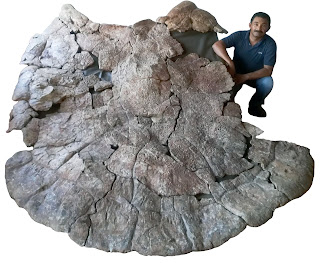Although most of the skeletal features differentiating birds from other extant vertebrates can be traced back to the Mesozoic dinosaurs (Makovicky; Zanno, 2011; Xu et al., 2014a), the integration of the fossil record of stem-avians — all taxa closer to birds than crocodiles — with the developmental biology of living birds is more controversial.
The evolution of the three-fingered hand of birds from the ancestral pentadactyl condition of tetrapods is still debated, the former having been considered alternatively as homologous to the medial most three (I–II–III) or the central (II–III–IV) fingers of reptiles (Wagner & Gauthier, 1999; Bever, Gauthier & Wagner, 2011; Xu et al., 2014a).
This controversy has often been depicted as a dichotomy between a paleontological approach supporting the I–II–III pattern in three-fingered theropods, Tetanurans, and a developmental approach supporting the II–III–IV pattern based on the topology of the embryonic mesenchymal condensations from which the avian digits develop (Wagner & Gauthier, 1999).
Yet, both fossil and embryological data are involved in the two alternative interpretations (Bever, Gauthier & Wagner, 2011; Vargas et al., 2008; Xu et al., 2009; Tamura et al., 2011), and may eventually support additional, more complex, homology frameworks (Xu et al., 2014a). Pivotal among the fossil evidence, the unusual hand of the Late Jurassic ceratosaurian Limusaurus has been argued to support a II–III–IV digital identity in birds and a complex pattern of homeotic transformations in three-fingered, Tetanuran, theropods (Xu et al., 2009; Bever, Gauthier & Wagner, 2011), although criticism to this interpretation has been raised from both paleontological and developmental perspectives (Wang et al., 2011; Carrano & Choiniere, 2016).
Following the reinterpretation of the digital identity along the avian stem of Xu et al. (2009), a series of paleontological studies in the last decade used the II–III–IV homology pattern as a morphological framework for three-fingered theropods, challenging the I–II–III pattern traditionally followed in the interpretation of the theropod hand (Xu, Han & Zhao, 2014b). It must be remarked that the evolutionary scenario supporting the II–III–IV homology pattern of Xu et al. (2009) makes predictions that can be falsified in the fossil record (Bever, Gauthier & Wagner, 2011): the phalangeal formula at the root of Ceratosauria should be markedly simplified, compared to the ancestral theropod formula (i.e., 0-3-3/2-1-X vs 2-3-4-1-0).
The new ceratosaurian theropod,
Saltriovenator zanellai, from the Saltrio Formation, Lower Jurassic, Lower Sinemurian, ∼198 million-year-old outcrops of Northern Italy (Dal Sasso, 2003), show a mosaic of features seen in four-fingered theropods and in basal tetanurans. Although fragmentary, the new theropod allows the reconstruction of the ancestral ceratosaurian hand, shedding light on the evolutionary digit pattern in tetanuran fingers and thus along the lineage leading to bird origin. The occurrence of large averostran theropods in the fossil record also helps us to understand the body size of this new Italian specimen and its stratigraphic and geochronological context.
The new find, in the context of Early Jurassic neotheropods Skeletal remains of theropod dinosaurs are extremely rare in the Lower Jurassic and most reports are of only fragmentary remains (Benton, Martill; Taylor, 1995; Owen, 1863; Woodward, 1908; Andrews, 1921; Cuny & Galton, 1993; Delsate & Ezcurra, 2014).
Ceratosaurian-grade taxa are absent until Middle Jurassic times (Maganuco et al., 2007; Pol & Rauhut, 2012), with one exception from the Pliensbachian–Toarcian of Northern Africa (Allain et al., 2007). This paucity of skeletal remains is a considerable gap in our knowledge of these animals at a time when theropods were diversifying rapidly. Just after the Triassic–Jurassic mass extinction event we begin to see a rich, worldwide distribution revealed through ichnofossils (Delsate & Ezcurra, 2014).
In Europe, we find theropod remains from the Hettangian, mostly non-diagnostic at the generic level: Scotland (Benton, Martill & Taylor, 1995), England (Owen, 1863; Woodward, 1908; Andrews, 1921), France (Cuny & Galton, 1993), and Luxembourg (Delsate & Ezcurra, 2014).
Two species of the genus Sarcosaurus have been reported from the Hettangian of England,
S. woodi from Barrow upon Soar, Leicestershire, based on an isolated pelvis, vertebra, and proximal femur (BMNH 4840/1), and
S. andrewsi (Huene, 1932), based on a partial tibia (NHMUK R3542) (Woodward, 1908).
There's also the neotheropod
Dracoraptor hanigani, from the Hettangian of Wales, described by Martill et al. in 2016 on the basis of a 40% complete skeleton including cranial and postcranial material. In the rest of the world, the most famous Early Jurassic theropod is certainly
Dilophosaurus wetherilli from the Hettangian of Arizona (Welles, 1954, 1984), which is known from several specimens.
Other relevant taxa are Sinosaurus (=“Dilophosaurus” sinensis) from the Hettangian–Sinemurian of China (Hu, 1993), Coelophysis rhodesiensis from the Hettangian–Pliensbachian of South Africa and Zimbabwe (Raath, 1990), a personal favourite
Dracovenator from the Hettangian of South Africa (Yates, 2005),
Cryolophosaurus from the Early Jurassic (?Sinemurian–Pliensbachian) of Antarctica (Hammer & Hickerson, 1994),
Podokesaurus from the Pliensbachian to Toarcian of Massachusetts (Talbot, 1911), Segisaurus from the Pliensbachian to Toarcian of Arizona (Carrano, Hutchinson & Sampson, 2005), “
Syntarsus”
kayentakatae from the Hettangian of Arizona (Rowe, 1989), and
Berberosaurus from the Toarcian of Morocco (Allain et al., 2007).
Ignored is the enigmatic genus
Eshanosaurus from the Lower Jurassic of China, tentatively dated as Hettangian (Xu, Zhao & Clark, 2001), pending correct identification and reliably dating, as this purported therizinosaurian coelurosaur might just well be a sauropodomorph.
In this context, the discovery of the new specimen from the Sinemurian of Italy is extremely relevant as it is among the oldest Jurassic theropods, it is larger than all other pre-Aalenian theropods and it helps us to understand some of the macroevolutionary patterns that would have characterized the evolution of Theropoda during the Jurassic.
It also represents the first dinosaur skeleton from the Italian Alps, the first of Jurassic age, and the second theropod skeleton found in Italy after
Scipionyx samniticus (Dal Sasso & Signore, 1998; Dal Sasso & Maganuco, 2011). The discovery of the specimen was described accidentally. For a more detailed account, see Dal Sasso, 2004 or the post here from March 9, 2020.


































